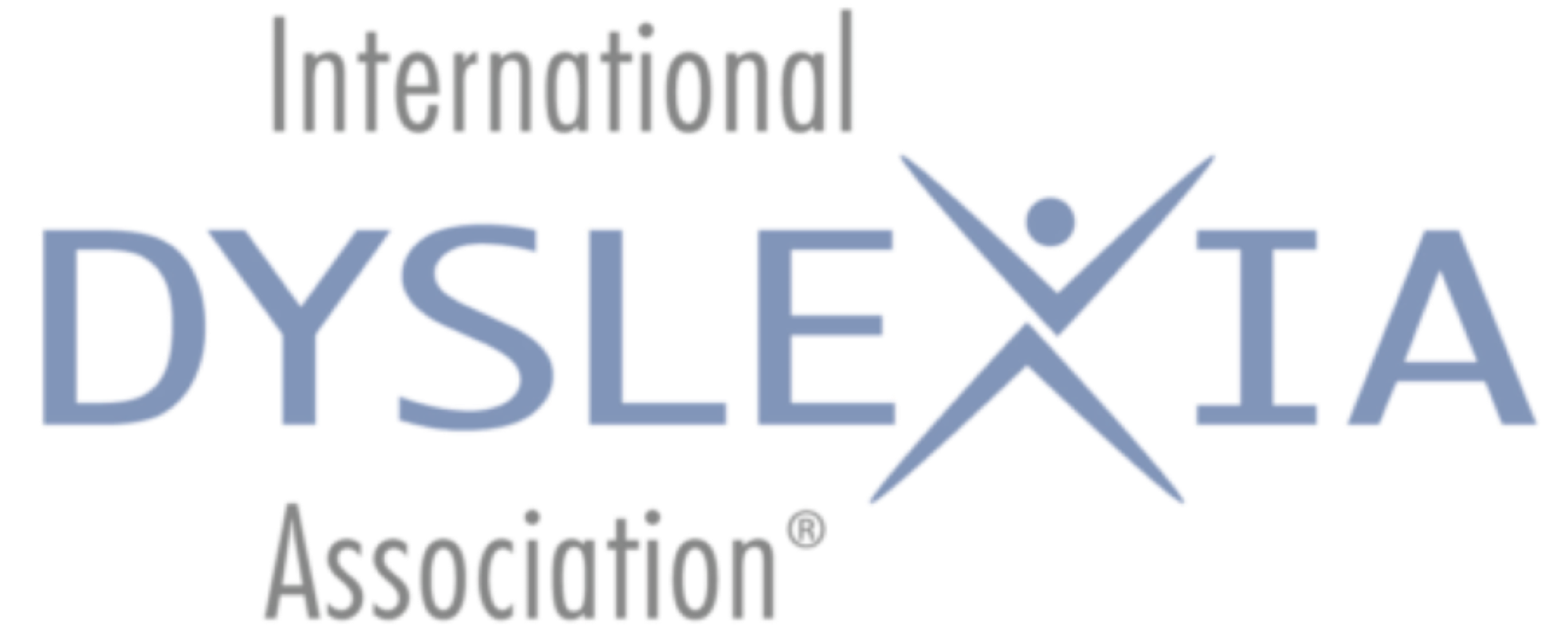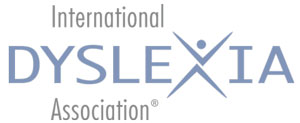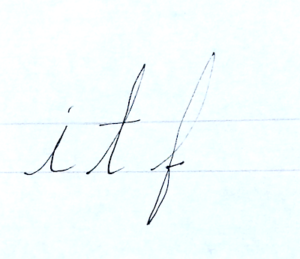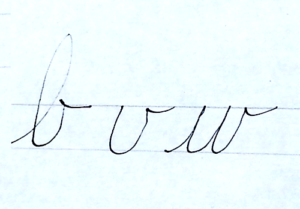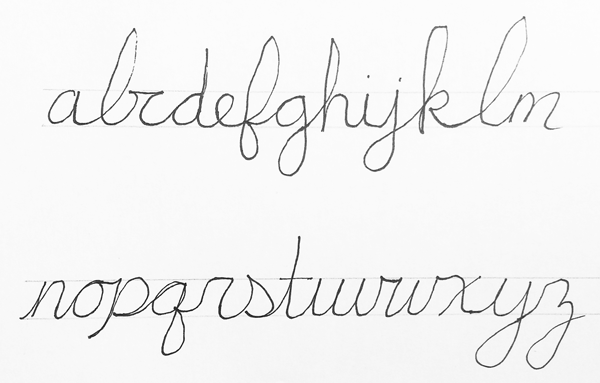April-May 2015
By Diana Hanbury King
In the first place, cursive is undeniably much faster. “Kate Gladstone, a handwriting specialist based in Albany, estimates that while a student needs to jot down 100 legible words a minute to follow a typical lecture, someone using print can manage only 30” (Freedman, 2005).
When writing cursive, the word becomes a unit, rather than a series of separate strokes, and correct spelling is more likely to be retained.
All lower case cursive letters can begin on the line, so fewer of them are likely to be reversed.
Most critically, handwriting engages more cognitive resources than keyboarding does (Berninger, 2012).
Other benefits from teaching cursive include the ability to read cursive. The Declaration of Independence and many other important archival documents are written in cursive. A cursive signature is more difficult to forge than a printed one.
Anna Gillingham advocated teaching cursive from the beginning, and many schools designed for students with dyslexia do the same (e.g., The Kildonan School, Camperdown Academy, and Sandhills School). In France, and in many other European countries, cursive is taught from the beginning.
It has been argued (by some who should know better) that learning to write using cursive makes it more difficult for beginning readers. This is simply not the case. Reading and writing, although both tasks involve written language processes, engage different circuits within the brain. First graders can easily master formation of lower-case cursive letters by Christmas. When working with older students from fourth or fifth grade on up, I have never needed to spend more than two weeks establishing formation of these letters. Upper case letters take longer, but students can certainly continue to print upper case letters in the meantime.
Before the student begins to write on paper, all cursive formations should be practiced with the student standing up and working on a whiteboard or chalkboard. The four-step multisensory procedure known as “Trace, Copy, Cover, Closed” is vital. (March 2015 Examiner) Be sure that each letter begins on the line and ends with a smile” that is the beginning of the connecting stroke to the following letter.
Use of “Simultaneous Oral Spelling” (i.e., SOS) is important. As students form each letter when writing a word, they say the letter name (not the sound) out loud. Say to the student, “Always tell your hand what to do.” This procedure, known as Simultaneous Oral Spelling, or SOS, reinforces letter formation.
From the beginning, it is essential to establish correct posture, paper position, and pencil grip:
- Posture
The student sits with back straight or tilted slightly forward and feet firmly on the floor. The desktop should be no more than two inches above the elbow when the arm is hanging down by the student’s side. If the desk cannot be adjusted, use a pillow and a box or stool so that the feet are not left to dangle. Both elbows should be on the table—we call this the “listening and learning position.” - Paper Position
The paper must be slanted at a forty-five degree angle that is parallel to the writing arm. Thus the arm can pivot freely from the elbow as the writing moves across the page. The non-writing hand is kept at the top of the page to anchor the paper and to move it up—like the roller in a typewriter. Correct positioning is especially important to avoid the left- handed hook. Anna Gillingham said that people who use this hooked position are “a monument to the ignorance or laziness of that child’s teacher.” Taping or painting a “V” at the bottom of the desk can serve as a reminder. Another method is to have parallel lines slanted according to the child’s handedness as a guide. - Pencil Grip
The pencil is gripped between the thumb and index finger, with the middle finger forming a shelf underneath. The end of the pencil should point toward the shoulder. All fingers are slightly bent. This is known as the “tripod grip” and is the most efficient.
There are various pencil grips and pencils on the market designed to help students hold their pencils appropriately. Avoid cheap ballpoints that write only when the pencil is held vertical to the paper. Sometimes gel pens or felt-tipped pens work best. Experiment to find what is most helpful to the individual.
Students should learn to write cursive letters in an order based on ease of formation. The “finish-later letters” (i.e., i, t, f, j) need special practice so that the student does not stop in the middle of the word in order to add the dot or the cross. The most difficult to connect are the ”bridge letters” (i.e., b, v, w). Connecting these letters requires targeted practice.
Practicing a letter formation a few times is more effective than writing endless lines of a single letter. Once the alphabet has been mastered, it should be practiced daily at the beginning of every session. The twenty-six letters should
be written in two lines, a to m and n to z like this:
Encourage students to work slowly and carefully at first. Eventually, they should be able to write the lower-case alphabet in less than two minutes.
Upper-case cursive letters are more problematic. All lower-case cursive letters begin on the line. In contrast, only four upper-case cursive letters begin on the line (i.e., I, J, G, and S). For this reason, cursive capitals are best taught in groups according to beginning strokes. Most cursive capital letters end on the line and join directly to the next letter, but six do not (i.e., D, P, T, V, W, X).
The earlier cursive is mastered, the more likely it is to become established as a life-long habit. Never forget: Writing exercises the brain, keyboarding the fingers.
REFERENCES
Berninger, V.W. (May-June 2012). Strengthening the Mind’s Eye: The Case for
Continued Handwriting Instruction in the 21st Century. Principal, 28-31.
Freedman, S. G. (January 19, 2005). Back to the Basics of a Legible Hand. On
Education. The New York Times.
Klemm, W.R. (March 14, 2013). Why Writing by Hand Could Make You Smarter.
Psychology Today.
Mueller, P.A. & Oppenheimer, D.M. (2014). The Pen Is Mightier Than the Keyboard: Advantages of Longhand Over Laptop Note Taking. Psychological Science, 25(6), 1159-1168.
Diana Hanbury King, Lit.hum.Dr.h.c., F/AOGPE, was the founder of Camp Dunnabeck in 1965 and co-founder of The Kildonan School in 1969. She was a Founding Fellow of the Academy of Orton-Gillingham Practitioners and Educators (AOGPE). Her vision created cutting edge education for students with dyslexia, and she developed a program for training teachers at Kildonan that has become a model program. Dr. King has also published teaching materials, particularly in the area of written language skills that have been used by thousands of educators throughout the world. The International Dyslexia Association awarded her the Samuel T. Orton Award in 1990 in recognition of her gifted teaching that “has enhanced beyond measure the quality of life for a myriad of dyslexic students and their families.” In 2013, she was awarded the Margaret Byrd Rawson Lifetime Achievement Award by IDA in recognition of her compassion, leadership, commitment to excellence, advocacy for people with dyslexia, and work nationally recognized as furthering the mission of IDA.
Copyright © 2015 International Dyslexia Association (IDA). We encourage sharing of Examiner articles. If portions are cited, please make appropriate reference. Articles may not be reprinted for the purpose of resale. Permission to republish this article is available from info@interdys.org.
